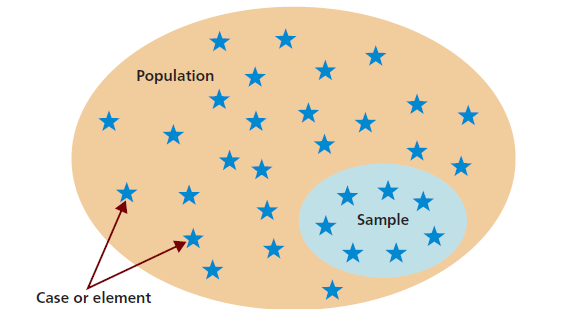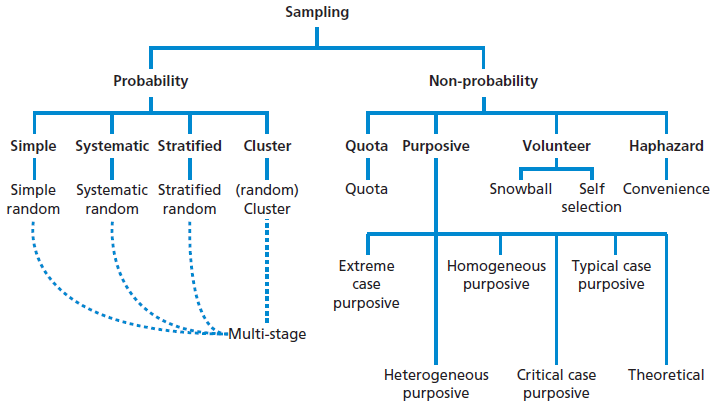Sampling
Sampling can be explained as a specific principle used to select members of population to be included in the study. It has been rightly noted that “because many populations of interest are too large to work with directly, techniques of statistical sampling have been devised to obtain samples taken from larger populations.”[1].
In other words, due to the large size of target population, researchers have no choice but to study the a number of cases of elements within the population to represent the population and to reach conclusions about the population (see Figure 1 below).
Figure 1. Population, sample and individual cases[2]
Brown (2006) summarizes the advantages of sampling in the following points[3]:
a) Makes the research of any type and size manageable;
b) Significantly saves the costs of the research;
c) Results in more accurate research findings;
d) Provides an opportunity to process the information in a more efficient way;
e) Accelerates the speed of primary data collection.
The Process of Sampling in Primary Data Collection
The process of sampling in primary data collection involves the following stages:
1. Defining target population. Target population represent specific segment within wider population that are best positioned to serve as a primary data source for the research. For example, for a dissertation entitled ‘Impact of social networking sites on time management practices amongst university students in the UK” target population would consist of individuals residing in the UK.
2. Choosing sampling frame. Sampling frame can be explained as a list of people within the target population who can contribute to the research. For a sample dissertation named above, sampling frame would be an extensive list of UK university students.
3. Determining sampling size. This is the number of individuals from the sampling frame who will participate in the primary data collection process. The following observations need to be taken into account when determining sample size:
a) The magnitude of sampling error can be diminished by increasing the sample size.
b) There are greater sample size requirements in survey-based studies than in experimental studies.
c) Large initial sample size has to be provisioned for mailed questionnaires, because the percentage of responses can be as low as 20 to 30 per cent.
d) The most important factors in determining the sample size include subject availability and cost factors
For example, for the same research of ‘Impact of social networking sites on time management practices amongst university students in the UK’ sample size could be determined to include 200 respondents.
4. Selecting a sampling method. This relates to a specific method according to which 200 university students in the UK are going to be selected to participate in research named above.
5. Applying the chosen sampling method in practice.
Types of Sampling in Primary Data Collection
Sampling methods are broadly divided into two categories: probability and non-probability.
In probability sampling every member of population has a known chance of participating in the study. Probability sampling methods include simple, stratified systematic, multistage, and cluster sampling methods.
In non-probability sampling, on the other hand, sampling group members are selected on non-random manner, therefore not each population member has a chance to participate in the study. Non-probability sampling methods include purposive, quota, convenience and snowball sampling methods. The Figure 2 below illustrates specific sampling methods belonging to each category:
Figure 2. Categorisation of sampling techniques
The following table illustrates brief definitions, advantages and disadvantages of sampling techniques:
| Technique | Definition/
Explanation |
Advantages | Disadvantages |
| Random | Sample group members are selected in a random manner | Highly effective if all subjects participate in data collection | High level of sampling error when sample size is small |
| Stratified | Representation of specific subgroup or strata | Effective representation of all subgroups
Precise estimates in cases of homogeneity or heterogeneity within strata |
Knowledge of strata membership is required
Complex to apply in practical levels |
| Systematic | Including every Nth member of population in the study | Time efficient
Cost efficient |
High sampling bias if periodicity exists |
| Multistage | Sampling conducted on several stages | High level of flexibility at various levels | Complex to conduct
Impacted by limitations of cluster and stratified sampling methods |
| Cluster | Clusters of participants representing population are identified as sample group members | Time efficient
Cost efficient |
Group-level information needs to be known
Usually higher sampling errors compared to alternative sampling methods |
| Judgement | Sample group members are selected on the basis of judgement of researcher | Time efficiency
Samples are not highly representative |
Unscientific approach
Personal bias |
| Quota | Sample group members are selected on the basis of specific criteria | High level of reliability than random sampling
Usually cost-effective |
High level of subjectivity
Difficult to estimate sampling error |
| Convenience | Obtaining participants conveniently with no requirements whatsoever | High levels of simplicity and ease
Usefulness in pilot studies |
Highest level of sampling error
Selection bias |
| Snowball | Sample group members nominate additional members to participate in the study | Possibility to recruit hidden population | Over-representation of a particular network
Reluctance of sample group members to nominate additional members |
My e-book, The Ultimate Guide to Writing a Dissertation in Business Studies: a step by step approach contains a detailed, yet simple explanation of sampling methods. The e-book explains all stages of the research process starting from the selection of the research area to writing personal reflection. Important elements of dissertations such as research philosophy, research approach, research design, methods of data collection and data analysis are explained in this e-book in simple words.
John Dudovskiy
[1] Proctor, T. (2003) “Essentials of Marketing Research”, 3rd edition, Prentice Hall
[2] Source: Saunders, M., Lewis, P. & Thornhill, A. (2012) “Research Methods for Business Students” 6th edition, Pearson Education Limited
[3] Brown, R.B. (2006) “Doing Your Dissertation in Business and Management: The Reality of Research and Writing” Sage Publications



